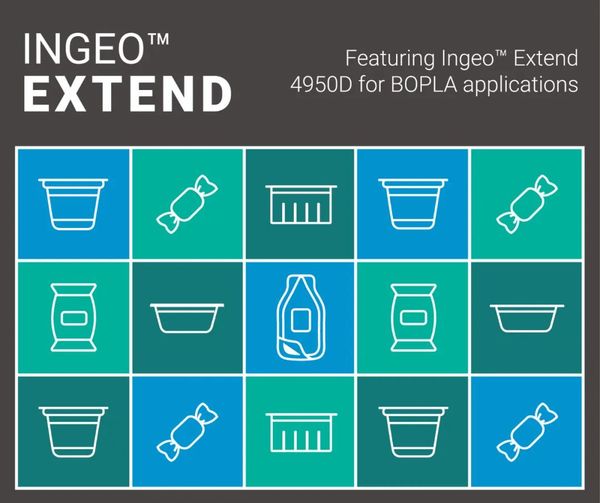Degradation speed increased by 8 times! NatureWorks launches new PLA product.
Recently, NatureWorks, a leading company in the field of biomaterial manufacturing, announced the launch of the Ingeo™ Extend platform and the Ingeo Extend 4950D product, bringing innovative changes to the production of biaxially oriented polylactic acid (BOPLA) films, and demonstrating great potential for application in areas such as food packaging.
Ingeo Extend 4950D is developed based on the new Ingeo™ PLA polymer platform, demonstrating significant advantages in the production of BOPLA films. For machinery originally designed for producing other polymers such as polypropylene, using Ingeo Extend 4950D allows biaxial stretching film manufacturers to achieve up to seven times the lateral stretch. This feature not only significantly enhances production efficiency but also substantially reduces production costs. In production scenarios such as coffee capsules, candy packaging, and single-serve food packaging bags, this product holds considerable value in optimizing production processes and controlling costs.

Image Source: NatureWorks
In terms of degradation performance, Ingeo Extend 4950D excels remarkably. Products within the Ingeo Extend platform demonstrate a composting degradation rate up to 8 times faster compared to other existing PLA grades. Additionally, Ingeo Extend 4950D can be blended with other Ingeo PLA grades. In PLA blends, as the amount of Ingeo Extend 4950D varies, the resulting biaxially oriented films exhibit altered degradation rates, all of which degrade faster than unmodified Ingeo PLA. This characteristic holds significant importance in addressing environmental pollution caused by traditional plastic packaging waste, particularly for small food packaging that is difficult to recycle. It provides an effective approach toward achieving green circular utilization of packaging materials.
From the perspective of film performance, Ingeo Extend 4950D also offers numerous advantages. In terms of sealing performance, particularly in co-extruded film structures, when the sealing layer content reaches 15%, the film's sealing effectiveness is significantly improved. Additionally, the new BOPLA film made from Ingeo Extend 4950D exhibits excellent heat resistance, capable of withstanding high temperatures of 130–140°C, along with outstanding transparency and mechanical properties, and low shrinkage. These characteristics enable the film to provide superior protection for food, effectively extending shelf life and meeting the stringent functional and quality requirements of food packaging.
With the implementation of the U.S. Extended Producer Responsibility legislation and the European Packaging and Packaging Waste Regulation (PPWR), market demand for compostable flexible films and food packaging is experiencing rapid growth to meet waste diversion targets. The emergence of the Ingeo Extend platform technology offers a cost-effective and high-performance compostable packaging solution. This technology is suitable for various product packaging that carries food residues, is difficult to recycle, and challenging to scale for recyclability, such as seasoning packets, snack and candy wrappers, salad bags, coffee capsule lids, and sauce cup covers. It plays a significant role in promoting the sustainable development of the packaging industry.
Using compostable packaging to divert food waste from landfills to composting has significant environmental benefits. Research data shows that replacing fossil-based plastics with Ingeo can reduce the carbon footprint of packaging by an average of 73%. The decomposition of food waste in landfills generates methane, which is the third-largest source of methane emissions globally. Composting food waste not only effectively reduces methane emissions but also produces a soil amendment that improves soil structure, aiding in soil carbon sequestration. Additionally, research from HYDRA Marine Science has confirmed that Ingeo PLA does not produce persistent microplastics in the environment, further highlighting its environmental value.
【Copyright and Disclaimer】The above information is collected and organized by PlastMatch. The copyright belongs to the original author. This article is reprinted for the purpose of providing more information, and it does not imply that PlastMatch endorses the views expressed in the article or guarantees its accuracy. If there are any errors in the source attribution or if your legitimate rights have been infringed, please contact us, and we will promptly correct or remove the content. If other media, websites, or individuals use the aforementioned content, they must clearly indicate the original source and origin of the work and assume legal responsibility on their own.
Most Popular
-

List Released! Mexico Announces 50% Tariff On 1,371 China Product Categories
-

Nissan Cuts Production of New Leaf EV in Half Due to Battery Shortage
-

New Breakthrough in Domestic Adiponitrile! Observing the Rise of China's Nylon Industry Chain from Tianchen Qixiang's Production
-

Dow, Wanhua, Huntsman Intensively Raise Prices! Who Controls the Global MDI Prices?
-

Mexico officially imposes tariffs on 1,400 chinese products, with rates up to 50%






